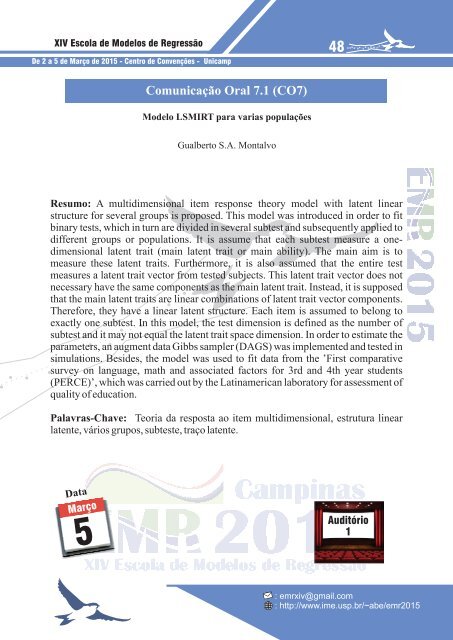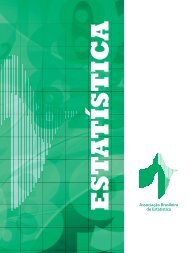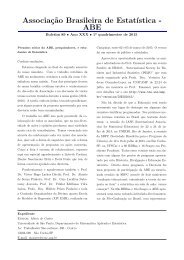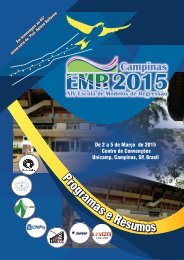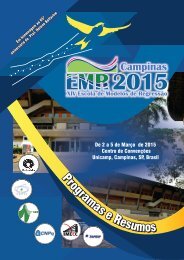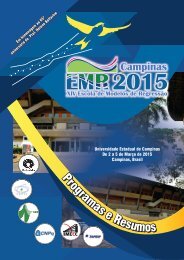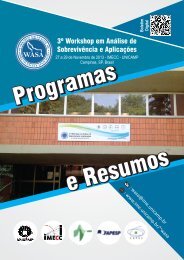Boletim do resumo e programas (XIV EMR 2015)
A Escola de Modelos de Regressão (EMR) é um evento científico na área de Estatística, de repercussão nacional, realizado com o patrocínio da Associação Brasileira de Estatística (ABE) que, em 2015, se encontrará em sua 14ª edição.
A Escola de Modelos de Regressão (EMR) é um evento científico na área de Estatística, de repercussão nacional, realizado com o patrocínio da Associação Brasileira de Estatística (ABE) que, em 2015, se encontrará em sua 14ª edição.
You also want an ePaper? Increase the reach of your titles
YUMPU automatically turns print PDFs into web optimized ePapers that Google loves.
<strong>XIV</strong> Escola de Modelos de Regressão<br />
De 2 a 5 de Março de <strong>2015</strong> - Centro de Convenções - Unicamp<br />
48<br />
Comunicação Oral 7.1 ( CO7)<br />
Modelo LSMIRT para varias populações<br />
Gualberto S.A. Montalvo<br />
Resumo: A multidimensional item response theory model with latent linear<br />
structure for several groups is proposed. This model was introduced in order to fit<br />
binary tests, which in turn are divided in several subtest and subsequently applied to<br />
different groups or populations. It is assume that each subtest measure a onedimensional<br />
latent trait (main latent trait or main ability). The main aim is to<br />
measure these latent traits. Furthermore, it is also assumed that the entire test<br />
measures a latent trait vector from tested subjects. This latent trait vector <strong>do</strong>es not<br />
necessary have the same components as the main latent trait. Instead, it is supposed<br />
that the main latent traits are linear combinations of latent trait vector components.<br />
Therefore, they have a linear latent structure. Each item is assumed to belong to<br />
exactly one subtest. In this model, the test dimension is defined as the number of<br />
subtest and it may not equal the latent trait space dimension. In order to estimate the<br />
parameters, an augment data Gibbs sampler (DAGS) was implemented and tested in<br />
simulations. Besides, the model was used to fit data from the ’First comparative<br />
survey on language, math and associated factors for 3rd and 4th year students<br />
(PERCE)’, which was carried out by the Latinamerican laboratory for assessment of<br />
quality of education.<br />
Palavras-Chave: Teoria da resposta ao item multidimensional, estrutura linear<br />
latente, vários grupos, subteste, traço latente.<br />
Data<br />
Março<br />
5<br />
Auditório<br />
1<br />
: emrxiv@gmail.com<br />
: http://www.ime.usp.br/~abe/emr<strong>2015</strong>


